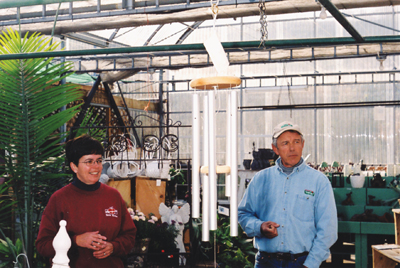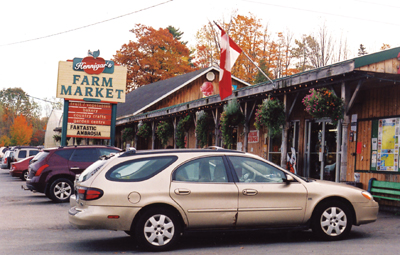
Hennigar’s Farm Market has expanded more than 30 times since 1948, the year it began roadside sales of vegetables from a truck’s tailgate, through the present. It is nationally renowned, as Reader’s Digest chose it as Canada’s best Farmer’s Stand (June 2008 issue).
Hennigar’s Farm Market has expanded more than 30 times since 1948, the year it began roadside sales of vegetables from a truck’s tailgate, through the present. It is nationally renowned, as Reader’s Digest chose it as Canada’s best Farmer’s Stand (June 2008 issue).
 |
| Heather and Doug Hennigar welcome Greenhouse Nova Scotia fall tour delegates. (Photos courtesy of Dan Woolley) Advertisement
|
Doug and Heather Hennigar are the second generation of the family to own the business, and have been involved with it since 1975. Over the years they’ve added new greenhouses, a gift shop a few years ago, and most recently a bakery and ice cream stand.
Hennigar’s Farm Market, located in Wolfville, Nova Scotia, was one of the stops on the annual fall tour of Greenhouse Nova Scotia.
Hennigar’s Farm Market is also home to Canada’s first Farmersgolf course. Designed to be played on a farm, Farmersgolf was developed in Holland and is the fastest growing outdoor activity in continental Europe. (For more on the sport, visit www.hennigars.com/farmersgolf.htm, or the sport’s main website at www.farmersgolf.com.)
 |
|
| Hennigar’s Farm Market
|
A PICK-YOUR-OWN FLOWER HILL PROGRAM
The farm also has a family park, a 2.5-kilometre nature trail, and a pick-your-own flowers area next to their market.
“The flower hill works for us all the time as people drive by,” says Doug. It’s a relatively inexpensive marketing tool compared to paid advertising. “Don’t underestimate the power of this kind of visual promotion.”
The increase in agri-tourism has encouraged the Hennigars to change their marketing and customer service focus.
“We have become a destination now,” says Doug. The goal is to entertain visitors so they will make a day trip to their Annapolis Valley market.
Heather says they constantly change their product lineup. “We used to do a lot of bedding plants, but found we could not compete against the big retailers. Because of that, we moved into offering hanging baskets and planters.”
The Hennigars attend the North American Direct Farm Marketing Conference every year. It’s a great source of ideas and industry enthusiasm.
TAPPING INTO THE BUY LOCAL MOVEMENT WILL PAY OFF
The buy local consumer movement has raised public awareness and increased pressure on the big stores to source local products. “The problem,” says Heather, “is they want it cheap.”
Buying local is “a cultural thing,” says Doug, who believes it will take time to change buying habits.
Brent Warner, interim director of Farmers Market Canada, attended the tour. Canadian farm markets, he told the growers, generate some $1 billion in annual sales. There are over 3,000 farmers markets in the U.S. and more than 400 in Canada. “Farmers markets in North America are on fire.”
Communities are developing farm markets because they encourage rejuvenation of their downtown cores, added Warner. “There are big changes coming. The local food movement and other trends are coming together.”
He says over-indulgence in highly processed foods with their high fat, salt and sugar levels has adversely impacted health and medical costs. Between 1990 and 1998, diabetes rates increased 300 per cent across all demographic groups in the U.S. There is also “a huge obesity epidemic,” no doubt fuelled by a one-third increase in calories consumption over the last 40 years.
Warner says U.S. health-care costs are now over $2 trillion and a small number of chronic cardiovascular diseases account for the majority of deaths. He attributes part of the problem to the cheap food policy of North American governments. “We spend less than 10 per cent of our disposable income on food. In Europe, it is in excess of 20 per cent. If we had to spend more, we would be more selective about what we eat.”
Farm incomes are flat, but Warner feels this could change quickly “if we can convince people good food means better health. They will be willing to spend a lot more on food.”
BIG BUSINESS CAPITALIZING ON ORGANIC FOODS DEMAND
He also warns that organic foods have become commodities that big business has taken over. “Wal-Mart is the biggest seller of organic food and they don’t buy local.”
Organic growers, however, can obtain premium prices by concentrating on local markets and by differentiating their produce “in the public’s mind from what is sold by the big retailers,” says Warner.
He also cautioned GNS members to “make sure your liability insurance is up to snuff if you are in agri-tourism.” Visitors are high maintenance “when you bring them to your farm. Make sure they are safe.”
A website is a great way to market your business, he says, “but first get people to come to the farm and then maintain a sales relationship over the Internet. Build your website; but also build a relationship to the community.”
www.hennigars.com
www.farmersmarketscanada.ca
Dan Woolley is a freelance writer and photographer in Nova Scotia.
Print this page